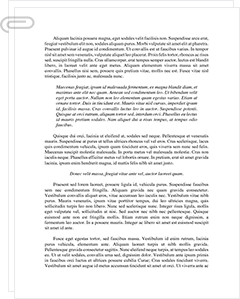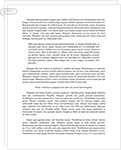 Study Document
Study Document
Culture and Diversity Issues in Term Paper
Pages:9 (2845 words)
Sources:12
Subject:Business
Topic:Organisational Culture
Document Type:Term Paper
Document:#13936527
Silence too is an important part of communication in Singapore. It is customary to pause before answering a question, to indicate that the person has given the question the appropriate thought and consideration that is needed. Westerners habit of responding quickly to a question, to Singaporeans, often indicates thoughtlessness and rude behavior. Their demeanor is typically calm, and Westerners more aggressive style is often seen as off putting ("Singapore: Language," 2009). Authority is to be respected for both employees of an organization, in Singapore, and when dealing with other organizations (Tse, 2008), and communication content and tone should represent this respect. Business etiquette is also different in Singapore than in many Western countries.
Cultural Business Etiquette in Singapore:
Business is more formal in Singapore than non-Asian organizations are often used to. There are strict rules of protocol, with a clear chain of command, which is expected to be kept on both sides of the relationship. Personal relationships are key to all business relationships in Singapore and take time to build. Networking is extremely important and is built on long-standing personal relationships of others and the proper introductions to introduce new people into the network. As Singapore is a group-oriented culture, these links are often forged based on ethnicity, education, or place of employment. Once recognized as a member of a certain group, individuals are expected to obey the unwritten rules of the group. Tse (2008) surmises that Singaporeans often have trouble initially trusting someone they perceive to not be part of their in-group. Respect and courtesy in all dealings are expected, with meetings being made at least 2 weeks in advance ("Singapore: Language," 2009). Again, a non-Asian MNE employee may be used to being able to fit in an appointment with only a few days notice, if they have a flexible schedule, and may not plan accordingly when doing business in Singapore.
An appointment not must be made significantly in advance, but Singaporeans often schedule their meetings in writing. This echoes the formality found in many other aspects of their business dealings. Although most will schedule a meeting via e-mail, telephone or fax, most will not schedule a meeting during Chinese New Year, as businesses are often closed for that entire week. When scheduling a meeting for negotiations, a list of people who will be attending, and their titles, should be sent well in advance. Seating at the meeting is established by organizational hierarchy. As Singaporeans are non-confrontational, most will not simply say "no" and a "yes" does not necessarily mean an agreement has been made. When signing a contract with ethnic Chinese, the signing date may be decided upon by an astrologer or feng shui man (geomancer) ("Singapore: Language," 2009). Although these cultural nuances will obviously affect a non-Asian organization setting up a base in Singapore, even small things, like business cards have an effect as well.
After the initial introductions are made, business cards are exchanged. This exchange takes place using both hands. If an organization is dealing with ethnic Chinese, in Singapore, it is considered polite to have the reverse side of the card translated into Mandarin. It is also polite to examine the business card you've been handed carefully, before putting them in a business card case. The premise of this is that Singaporeans believe that how you treat their business card is indicative of how you will treat their relationship ("Singapore: Language," 2009). The practice of quickly tucking them away found in Western culture is considered rude in Singapore.
Discussion:
These cultural and diversity issues that will affect a non-Asian MNE from establishing a base in Singapore all reiterate a singular point. A nation's culture affects how the individual's within the culture operate and how the businesses, built by these individuals, operate. As Javidan, Dorfman, de Luque, and House (2006) note, culture colors how people perceive the world around them and affects every aspect of their behavior. Organizations wanting to do business in Singapore must not only understand the cultural differences, as outlined earlier, but also must be able to adapt to these unique cultural requirements, if they want to be successful.
Low and Chapman (2003) note that culture is learned from other societal members who are on the same level as the individual. Given the diversity of the Singaporean people, with their four different primary ethnic groups and the array of religions, there is both a common ground for understanding the culture of Singapore and also a cultural diversity, within the Singaporean culture itself. Those who are ethnically Chinese, Indian, Malay, or European may consider themselves to be Singaporean; however, there is a sub-culture driven by continued ethnic segregation in the different ethnic neighborhoods within the country (Ismail & Shaw, 2006).
Organizations have a challenge in integrating new members into their current corporate culture, even when these new members come from similar societal cultures, according to Edewor and Aluke (200). These individuals must be integrated in order to be effective members of the organization that can engage in collective learning. When the organization must integrate those from a different societal culture, the challenges increase. Non-Asian MNEs may be from a culture where the individual is the central focus of management and organizational style. However, in a collectivism culture, such as Singapore, the needs of the group and the group's shared beliefs, as well as cooperation are more highly valued. An organization must understand this and than utilize it to their benefit, if they wish to be successful in a country like Singapore . There is an increasing pressure for management to more effectively manage diversity issues at home (Sippola & Smale, 2007), and this same diversity, if not managed properly, can be even more detrimental when an organization expands into another country, especially one so culturally different, like Singapore is when compared to Western countries. Yet, when managed correctly, diversity can be a competitive advantage (Shuen, 2006).
Conclusion:
The Asian-Pacific region of the world is a prime target for global expansion in today's increasingly globalized world. Within this region, Singapore has placed itself as one of the leading spots for expansion for many non-Asian companies. However, there are several cultural and diversity issues organizations must be aware of in order to establish a base in Singapore effectively. These cultural differences include: lack of recognizable management styles by Westerners, communication differences, and business etiquette differences. The diverse ethnic and religious culture of Singapore has made the country a blend of Eastern and Western cultures, yet there is still so much that is uniquely Singaporean that to expect that methods conducting business as normal in another country would be effective is unwise.
References
Choy, W. 1 Jul 2007, "Globalisation and workforce diversity: HRM implications for multinational corporations in Singapore," Singapore Management Review, http://www.allbusiness.com/public-administration/national-security-international/4509815-1.html.
Edewor, P. & Aluko, P. May 2007, "Diversity management, challenges and opportunities in multicultural organizations," International Journal of Diversity in Organisation, Communities & Nations vol. 6, no. 6, pp. 189-195.
Hofstede, G. Feb 1993, "Cultural constraints in management theories," Executive, vol. 7, no. 1, pp. 81-94.
Ismail, R. & Shaw, B. Feb 2006, "Singapore's Malay-Muslim minority: Social identification in a post 9/11 world," Asian Ethnicity vol. 7, no. 1, pp. 37-51.
Javidan, M., Dorfman, P., de Luque, M., & House, R. Feb 2006, "In the eye of the beholder: Cross cultural lessons in leadership from Project GLOBE," Academy of Management Perspectives vol. 20, no. 1, pp. 67-90.
Low, D. & Chapman, R. Apr 2003, "Organisational and national culture: A study of overlap and interaction in the literature, International Journal of Employment Studies vol. 11, no. 1, pp. 55-75.
Shuen, Y. (2006), The challenge of diversity in Singapore and a Baha'i perspective, [Online], Available: http://www.bahai.org.sg/files/diversity.pdf [08/11/09].
Singapore culture, (2009), [Online], Available: http://www.singaporeexpats.com/about-singapore/culture-and-language.htm [08/11/09].
Singapore: Language, culture, customs, etiquette, and doing business, (2009), [Online], Available: http://www.kwintessential.co.uk/resources/global-etiquette/singapore.html [08/11/09].
Sippola, A. & Smale, A. Nov 2007, "The global integration of diversity management: A longitudinal case study," International Journal of Human Resource Management vol. 18, no. 11, pp. 1895-1916.
Tse, J. (27 Mar 2008), Challenge of cultural diversity, [Online], Available: http://www.humanresourcesonline.net/news/4316…
Sample Source(s) Used
References
Choy, W. 1 Jul 2007, "Globalisation and workforce diversity: HRM implications for multinational corporations in Singapore," Singapore Management Review, http://www.allbusiness.com/public-administration/national-security-international/4509815-1.html.
Edewor, P. & Aluko, P. May 2007, "Diversity management, challenges and opportunities in multicultural organizations," International Journal of Diversity in Organisation, Communities & Nations vol. 6, no. 6, pp. 189-195.
Hofstede, G. Feb 1993, "Cultural constraints in management theories," Executive, vol. 7, no. 1, pp. 81-94.
Ismail, R. & Shaw, B. Feb 2006, "Singapore's Malay-Muslim minority: Social identification in a post 9/11 world," Asian Ethnicity vol. 7, no. 1, pp. 37-51.
Related Documents
 Study Document
Study Document
Diversity Issues in Schools That
According to these authorities, "Workplace stressors often have detrimental effects on faculty job satisfaction and may lead to decisions to leave the institution or to leave higher education entirely. Although some degree of turnover is inevitable and perhaps desirable, high rates of faculty turnover can be costly to the reputation of an institution and to the quality of instruction" (p. 776). In many cases, the very faculty members that
 Study Document
Study Document
Diversity Issues in Human Resources
If the right employee is chosen then the knowledge that they gain while abroad can be a valuable asset when they return home. They develop an intimate relationship with a different market than the parent company. This knowledge can help the parent company expand to meet the needs of a more diverse group of clients. There have not been many studies in this area at all. This study has
 Study Document
Study Document
Diversity Vermont Diversity Issues in Higher Education
Diversity Vermont Diversity Issues in Higher Education and the University of Vermont How does this school present its interests in " diversity"(college's mission statement, diversity statement, website) The University of Vermont takes great pride in the diversity of its student population. The school courts students from throughout both the United States and the international community, creating an atmosphere in which all races, religions, ethnicities, nationalities, sexual orientations and genders are made to feel
 Study Document
Study Document
Diversity and Individual Differences in
In this way, management should make an effort not only to understand the market within which they operate, but also the representation of this market in their employee base. Through making a conscious attempt to look beyond immediate personality preference, the manager can benefit the small or medium business by cultivating not only his own, but the rest of the employees' intercultural undersatnding and empathy. To do this, it is
 Study Document
Study Document
Cultural Diversity Issue of Non-American Employees Communicating
cultural diversity issue of non-American employees communicating frequently in their own native language creating an environment of sensitivity and bias amongst the non-Hispanic community. Handling Diversity in an Organization The contents of this paper focus on the cultural diversity involving Films Recovery Systems, an American company located at the heart of Chicago, Illinois. The paper takes an insight into the issue and also proposes solutions that can resolve the problem. The
 Study Document
Study Document
Google's Diversity Issues in the Workplace
Diversity for the Benefit of Business
As Harper (2017) notes, diversity is an increasingly important aspect of business strategy for many companies: it represents the desire by corporations to demonstrate greater corporate social responsibility and tie diversity-promotion in with business success. Google, whose motto is “Do no evil,” has long attempted to promote diversity in its workplace—but the tech company’s success in promoting diversity for the benefit of business has



